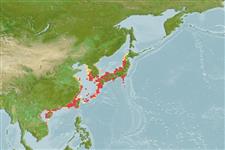>
Gobiiformes (Gobies) >
Oxudercidae (Mudskippers) > Periophthalminae
Etymology: Periophthalmus: Greek, peri = around + Greek, ophthalmos = eye (Ref. 45335).
Issue
Eschmeyer (CofF ver. Sep. 2011: Ref. 88002) recognizes Periophthalmus cantonensis (Osbeck, 1765) as valid on the basis of Cyprinus ccantonensis Osbeck, 1865 after several publications posterior to Murdy (1989: Ref. 5218) but without mentioning the later author that we follow here, The original description must be re-assessed as there is few chances that it is a Gobiidae. See Murdy (1989) for the history of that name.
Environment: milieu / climate zone / depth range / distribution range
экология
морской; пресноводный; солоноватоводный демерсальный; амфидромный (Ref. 46888). Subtropical
Northwest Pacific: Vietnam (Ref. 44416), northward to Korea and southern Japan (Ref. 559).
Length at first maturity / Size / Вес / Возраст
Maturity: Lm ?, range 4 - ? cm
Max length : 10.0 cm TL самец/пол неопределен; (Ref. 5258)
Краткое описание
определительные ключи | морфология | морфометрия
Distinguished by the following characteristics: pelvic fins united anteriorly by a moderate
to strong frenum; medial rays united by a membrane for about half their length; D 1 height moderate, its margin rounded, a dusky stripe inframarginally and no spots on fin, no elongate spines; D2 with single dusky stripe inframarginally; dorsal fins not connected by membrane;
D I with 1O-l7 spines; longitudinal scale count 75-100; head width 14.1-19.8% SL; pelvic fin length 11.5-14.6% SL; length of anal fin base 16.1-22.2% SL; length of D2 base 19.8-24.1 % SL; total D2 elements 12-14; total anal fin elements 11-13; TRDB 19-29 (Ref. 5218).
Facultative air-breathing (Ref. 126274); Intertidal, actively shuttling back and forth between rock pools and air (Ref. 31184). They breathe air when out of water (Ref. 31184). Can stay out of the water for up to 22-60 hours if kept moist (Ref. 51276). Inhabits level mudflats with no vegetation (Ref. 92840). Found in estuaries, swamps, marshy areas and tidal mud flats. Moves around briskly on land preying on small animals. Used in Chinese medicine (Ref. 12166).
Life cycle and mating behavior
половая зрелость | размножение | нерест | икра | Fecundity | личинки
Murdy, E.O., 1989. A taxonomic revision and cladistic analysis of the oxudercine gobies (Gobiidae: Oxudercinae). Rec. Aust. Mus., Suppl. 11:1-93. (Ref. 5218)
Статус Красного Списка МСОП (Ref. 130435: Version 2024-1)
Угроза для людей
Harmless
Использование человеком
рыболовство: интереса не представляет; аквариум: коммерческий
дополнительная информация
инструменты
Специальные отчеты
Скачать в формате XML
ресурсы в Интернет
Estimates based on models
Preferred temperature (Ref.
123201): 16.3 - 26.7, mean 22 °C (based on 280 cells).
Phylogenetic diversity index (Ref.
82804): PD
50 = 0.5000 [Uniqueness, from 0.5 = low to 2.0 = high].
Bayesian length-weight: a=0.00832 (0.00538 - 0.01287), b=2.98 (2.85 - 3.11), in cm total length, based on LWR estimates for this species & (Sub)family-body (Ref.
93245).
Trophic level (Ref.
69278): 3.2 ±0.4 se; based on size and trophs of closest relatives
устойчивость к внешним воздействиям (Ref.
120179): высокий, минимальное время удвоения популяции до 15 месяцев (Preliminary K or Fecundity.).
Fishing Vulnerability (Ref.
59153): Low vulnerability (10 of 100).
